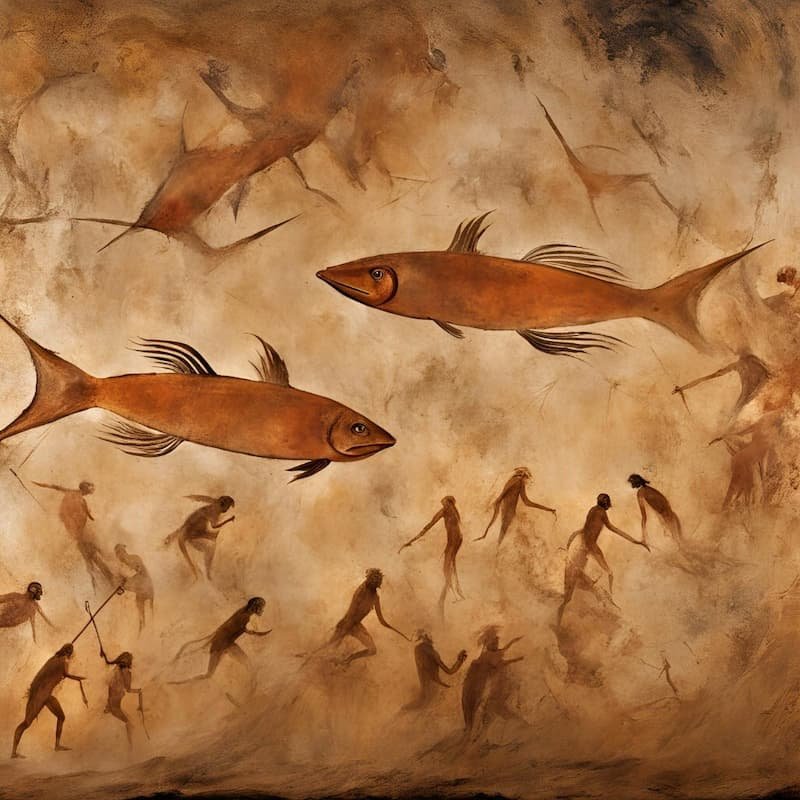
 Roni Essex
Freediver, Spearo, Creator
Roni Essex
Freediver, Spearo, Creator

 Roni Essex
Freediver, Spearo, Creator
Roni Essex
Freediver, Spearo, Creator
Spearfishing has a rich and storied past that stretches back thousands of years. Long before it evolved into the modern sport celebrated by enthusiasts today, spearfishing was a vital means of sustenance and survival for ancient civilizations across the globe. This article delves into the history and evolution of spearfishing, tracing its origins from primal necessity to a revered tradition.
Spearfishing's roots can be traced back to the Upper Paleolithic period, around 16,000 years ago, when early humans sought innovative ways to exploit aquatic resources. The ingenuity of these ancient peoples is evidenced by the discovery of primitive spears and harpoons fashioned from materials such as bone, wood, and stone. These tools, often barbed to secure slippery prey, were essential for hunting fish in shallow waters and along riverbanks.
One of the earliest depictions of spearfishing can be found in the cave paintings of the Cosquer Cave in France, dating back approximately 25,000 years. These artworks portray figures poised with spears, capturing the essence of early human interaction with aquatic environments. Such depictions underscore the importance of spearfishing as both a practical activity and a cultural touchstone.

As human societies evolved, so did their spearfishing techniques and technologies. In ancient Egypt, around 3000 BCE, the Nile River served as a lifeline for the civilization. Egyptians utilized spearfishing as a primary method for harvesting fish, an important food source. Hieroglyphics and tomb paintings vividly illustrate scenes of spearfishing along the Nile, with fishermen using simple yet effective tools such as wooden spears and tridents.
Similarly, the indigenous peoples of the Pacific Northwest Coast in North America demonstrated remarkable proficiency in spearfishing. The Tlingit, Haida, and other coastal tribes developed sophisticated methods, including the use of multi-pronged spears and underwater traps. Their deep understanding of marine ecosystems allowed them to sustainably harvest fish, ensuring the longevity of their communities.
In the Mediterranean, the Greeks and Romans also embraced spearfishing, refining the practice with advancements in technology and strategy. The philosopher Aristotle, in his work "History of Animals," described various spearfishing techniques employed by Greek fishermen, highlighting the skill and precision required to successfully capture fish. The Romans, meanwhile, incorporated spearfishing into their recreational activities, with historical records indicating that it was a popular pastime among the elite.

Perhaps no culture embodies the art of spearfishing more profoundly than the Polynesians. Spread across the vast expanse of the Pacific Ocean, Polynesian societies developed an unparalleled mastery of spearfishing, which was integral to their way of life. Utilizing canoes and outrigger vessels, Polynesian fishermen ventured into deeper waters, employing both hand-held spears and more elaborate mechanisms like the Hawaiian sling, a type of underwater spear gun.
Polynesian spearfishing was not merely a subsistence activity but also held significant cultural and spiritual importance. Rituals and ceremonies often accompanied fishing expeditions, underscoring the deep connection between the people and the sea. This reverence for the ocean and its bounty is reflected in the rich oral traditions and folklore of Polynesian societies, which celebrate the prowess and bravery of their fishermen.

The transition from ancient to modern spearfishing is marked by significant advancements in technology. Early spears and harpoons, crafted from natural materials, eventually gave way to metal-tipped weapons as metallurgical techniques improved. The introduction of iron and bronze allowed for more durable and effective spears, enhancing the efficiency of spearfishing.
In the 20th century, the development of underwater breathing apparatuses, such as snorkels and scuba gear, revolutionized the practice. Freedivers could now explore greater depths and remain submerged for longer periods, expanding the horizons of spearfishing. The invention of the spear gun in the mid-20th century further transformed the activity, providing greater accuracy and power, and making it accessible to a wider audience.

Spearfishing's significance extends beyond the practical and technological; it is deeply embedded in the mythology and folklore of many cultures. In ancient Greece, the god Poseidon was often depicted wielding a trident, symbolizing his dominion over the sea and its creatures. This imagery underscores the cultural importance of spearfishing and its association with divine power.
In Polynesian mythology, the god Maui is revered as a master fisherman who used his magical fishhook to pull entire islands from the ocean floor. This legendary tale reflects the profound respect and awe that Polynesian societies held for their marine environment and the art of fishing. Similarly, in Native American folklore, spearfishing features prominently in stories that convey moral lessons and cultural values, illustrating the integral role of this practice in their heritage.

As modern spearfishing continues to grow in popularity, it is essential to reflect on the practices of ancient civilizations, which often emphasized sustainability and respect for marine ecosystems. Indigenous cultures, in particular, demonstrated a keen awareness of the need to balance human activity with the health of the environment. Techniques such as seasonal fishing, selective harvesting, and the use of traditional ecological knowledge ensured that fish populations remained robust for future generations.
Today, spearfishing enthusiasts and conservationists alike can draw valuable lessons from these ancient practices. Sustainable spearfishing, guided by principles of ecological stewardship, is crucial in preserving the delicate balance of marine ecosystems. By adopting responsible fishing practices and advocating for the protection of endangered species and habitats, modern spearfishers can honor the legacy of their ancient counterparts and contribute to the conservation of our oceans.

Spearfishing, with its rich history and enduring appeal, continues to captivate and challenge those who seek to engage with the natural world in a profound way. From the early hunters of the Paleolithic era to the skilled fishermen of ancient civilizations, the practice of spearfishing has evolved and adapted, reflecting the ingenuity and resilience of humanity. As we look to the future, it is incumbent upon the spearfishing community to uphold the values of sustainability and respect for the marine environment, ensuring that this ancient tradition thrives for generations to come.
In celebrating the heritage of spearfishing, we acknowledge not only the skill and determination of our ancestors but also the deep connection between humans and the sea. This timeless tradition, born out of necessity and honed through millennia, remains a testament to the enduring bond between mankind and the ocean's depths.